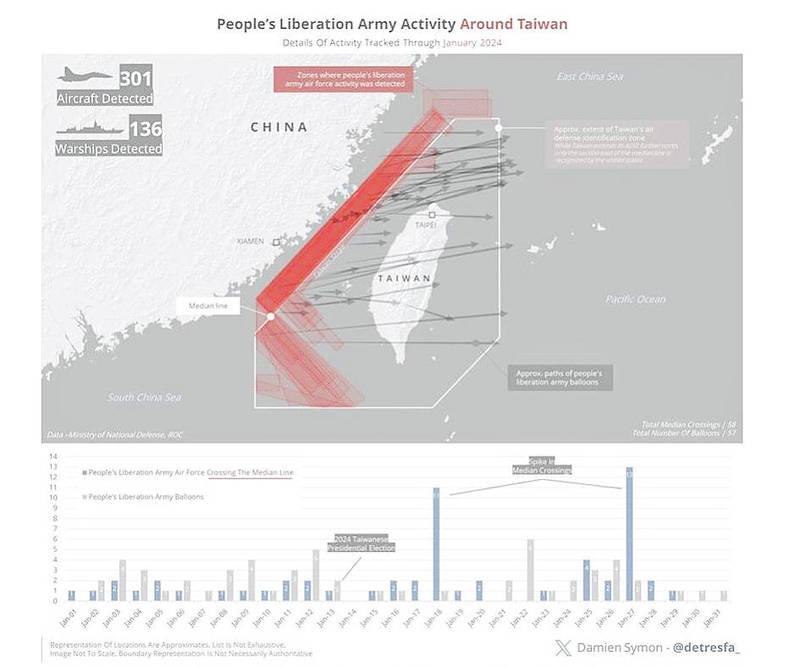《TAIPEI TIMES》 Lasers could counteract Chinese balloons: analysts

Chinese People’s Liberation Army aircraft and warship movements in the past month are depicted in an infographic created by open-source intelligence analyst Damien Symon. Photo: Screen grab from Symon’s X account
PSYCHOLOGICAL WARFARE: Institute of National Defense and Security Research fellow Su Tzu-yun said lasers are a far cheaper alternative to shooting missiles
By Liu Yu-chieh and Jonathan Chin / Staff reporter, with staff writer
An analyst has urged that Taiwan obtain laser weapon systems to counter Chinese balloons after the military last month detected 57 balloons in and around the nation’s airspace.
Aggregated Ministry of National Defense (MND) data showed that last month Beijing sent a flurry of balloons, including many that flew over the sea north of Taiwan proper and some that crossed the median line of the Strait, in addition to several that entered the nation’s airspace.
China sometimes simultaneously deployed as many as six balloons at a time during these operations, the data showed.
The balloons Taiwan encountered were smaller than the one that was shot down over the US and did not pose a serious threat due to the limited payload for weapons and surveillance equipment, Institute of National Defense and Security Research (INDSR) fellow Su Tzu-yun (蘇紫雲) said on Saturday.
Beijing’s use of balloons is part of its influence operations aimed at dealing psychological blows to Taiwanese by presenting the Chinese People’s Liberation Army’s (PLA) as being capable of penetrating the airspace of Taiwan proper, he said.
Should war break out, Beijing could force Taiwan’s armed forces to expend precious air defense missiles to shoot down the relatively low-cost balloons in a ploy to exhaust the defender’s ammunition, Su said.
A possible counter-tactic for Taiwan is the use of directed energy weapons, which cost a few US dollars per shot, whereas missile systems cost millions of US dollars per unit and could be fired only once, he said.
Laser weapons could destroy several targets in rapid succession, have a small logistical footprint, and remain in operation without relying on finite munition stockpiles so long as energy is supplied, Su said.
Chinese balloons have increasingly lengthened their loiter time and their flight path moved closer to Taiwan proper, said retired army major general Ko Yung-sen (柯永森), who is an INDSR fellow.
The PLA is poised to establish a “near space command,” a fifth branch of the Chinese armed forces that would control satellites, drones and balloons to achieve an integrated kill chain for hypersonic missiles and conventional platforms, he said.
China’s Taiwan Affairs Office spokesman Chen Binhua (陳斌華) on Thursday said the balloons floating over Taiwan were civilian craft utilized for peaceful purposes and presented “nothing new.”
Democratic Progressive Party authorities should not use the issue for “cognitive manipulation” that fans hostility across the Taiwan Strait, he said.
Taiwan’s Mainland Affairs Council spokesman Jan Jyh-horng (詹志宏) said Beijing was lying about the balloons.
“No private enterprise has the resources to waste balloons for no reason,” he said. “We completely reject these lies.”
Last month, 301 aircraft and 136 ship sorties were detected in the area surrounding Taiwan, including 58 aircraft sorties that flew over the median line of the strait, MND reports showed.
Many of these sorties flew over the sea to the southwest of Taiwan proper to menace the Pratas Islands (Dongsha Islands, 東沙群島) with aerial interdiction, while a smaller number flew over the nation’s northern waters.
Notably, the MND last month began publishing information on Chinese military aircraft flying beyond Taiwan’s air defense identification zone in a display of detection capabilities likely intended for China.
新聞來源:TAIPEI TIMES















